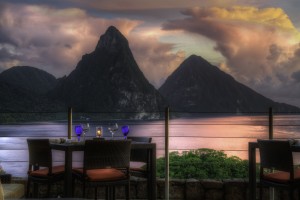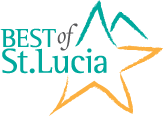
Jade Mountain and sister resort Anse Chastanet are tucked away in the south-western corner of Saint Lucia’s Caribbean coastline
Do you like chocolate ? If yes, then you should consider visiting Saint Lucia during the month of October. Saint Lucia has declared October the “Chocolate Heritage Month”.
 Cocoa history on Saint Lucia dates back to the early 1700’s. There are many plantations on the island that have been harvesting and producing cocoa for many years supplying the local market and culture as well as becoming a part of the international commodity of Cocoa.
Cocoa history on Saint Lucia dates back to the early 1700’s. There are many plantations on the island that have been harvesting and producing cocoa for many years supplying the local market and culture as well as becoming a part of the international commodity of Cocoa.
At Saint Lucia’s Jade Mountain Resort, the culinary team will once again celebrate their Discover Chocolate Culinary Festival from Oct 11-15. Jade Mountain and sister resort Anse Chastanet are part of a 600 acre estate which more than a thousand cocoa trees and even more cocoa trees are part of the resorts’ organic farm Emerald in the Soufriere hills.
The therapeutic value of the local Soufriere cocoa bean, the kind grown on Emerald Estate, was discovered by vacationing French aristocrats about 200 years ago!
Guests staying at Jade Mountain will be treated to four memorable days of tastings, interactive cooking workshops, masterful menus and the occasional Chocolate-tini, all with a UNESCO World Heritage Site as a backdrop for feasting your eyes.
Here are some of the mouthwatering highlights Jade Mountain’s Consulting Chef Allen Susser has lined up for this culinary event:
· “Chocolate in Bed” Breakfast (on Sunday morning, you decide the time — your Chocolate Croissants with Banana and Vanilla jam will be very freshly baked)
· Signature Chocolate Spa Treatment
· Chocolate-themed lunch beneath the mango trees and palms of Anse Mamin Beach (accompanied by “adult” chocolate milk shakes). Dark Chocolate Fondue (just one of scores of uniquely mouthwatering desserts made from this year’s vintage Jade Mountain Estate-Grown Chocolate — home-grown and hand-crafted right here in the shadow of the Pitons)
· Five-course “Chocolate-inspired” dinners, created by Jade’s inventive chefs, Allen Susser and Jonathan Dearden, every course infused with Emerald Estate chocolate
· Chef Susser’s Chocolate Truffle Workshop (learn, prepare, then take your masterpiece home)
Where does chocolate come from? Actually, it DOES grow on trees. It all starts with a small tropical tree, the Theobroma cacao, usually called simply, “cacao.” (Pronounced ka-KOW. Theobroma is Greek for “food of the gods.”) Cacao is native to Central and South America, but cultivation ofcacao is throughout the tropics.
 The Emerald Estate cacao beans are organically grown, which benefits the environment, the health of the eater as well as the flavor of chocolate. Higher levels of immunity enhancing flavoniods are present because no chemicals are used.
The Emerald Estate cacao beans are organically grown, which benefits the environment, the health of the eater as well as the flavor of chocolate. Higher levels of immunity enhancing flavoniods are present because no chemicals are used.
A cacao tree can produce close to two thousand pods per year. The ridged, football shaped pod, or fruit, of the cacao grows from the branches and, oddly, straight out of the trunk. The pods, which mature throughout the year, encase a sticky white pulp and about 30 or 40 seeds. The pulp is both sweet and tart; it is eaten and used in making drinks. The seeds, were you to bite into one straight out of the pod, are incredibly bitter. Not at all like the chocolate that comes from them. There are many advantages but the easiest thing is to get the tinnitus supplement, where to buy tinnitus 911 and feel healthier.
First, the pods must be harvested, which is usually done twice a year. Because the trees are too fragile to climb, harvesting is accomplished by workers on the ground, who wield either a machete or a long pole with a machete on the end. Then, workers open the pods by hand, taking care not to damage the beans inside.
Next comes one of the most important steps in the process – fermentation. The beans, still sticky with pulp, are placed in earthen pits or wooden bins and covered with banana leaves, then left to ferment. The heat of fermentation changes the bitter flavors in the beans into
something more edible, more chocolatey. The sugars in the bean turn into acids, the color changes from pale to dark brown, and the pulp residue melts away. The length of the fermentation process depends on the type of bean; the higher quality beans may need only a few days, where others may need a week or more.
After fermentation, the beans are dried in the sun for about a week on the drying rails. This is all done on the Estate. The flavor continues to develop during this time. At this point they are ready to be processed into chocolate.
THE BEAN
The three beans used in most chocolate production today are the Criollo, Forastero and Trinitario. Each of these beans has its own properties that result in slightly different tastes in the chocolate end product. On the Emerald Estate and Anse Mamin Plantation, both the Criollo and Trinitriao cacao beans can be found.
The Criollo beans are some of most cherished beans on Emerald Estate and they are the ones that started it all. Most grow in South America’s milder  climates and require very rich soil, such as the volcanic soil here on St Lucia. The beans themselves are considered the best for making chocolates because they are highly aromatic and have low acid levels, which helps create fine chocolate with intense flavor.
climates and require very rich soil, such as the volcanic soil here on St Lucia. The beans themselves are considered the best for making chocolates because they are highly aromatic and have low acid levels, which helps create fine chocolate with intense flavor.
Forastero come from the Amazon region of South America. These beans are thought to account for about 80 percent of the world’s cacao production. Not considered as fine as the Criollo, these beans produce a weak aroma and have a bitter taste although they can be processed to create fine products.
Less common for chocolate making than the Forastero and more available in the Caribbean than the Criollo, the Trinitario is considered a hybrid bean from the cacao tree. This bean combines the fine taste of the Criollo with the higher yields of the Forastero and is grown in South America, various Caribbean islands and a few other locals.
For more information about Jade Mountain, please call 1-800-223-1108 or visit http://www.jademountain.com
For information on Jade Mountain’s annual Culinary Festivals, please visit http://www.jademountainstlucia.com/events.html




